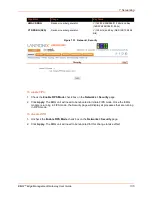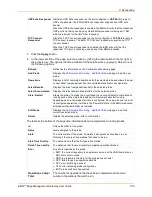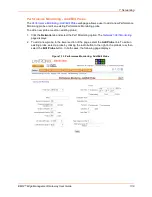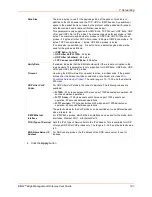
7: Networking
EMG™ Edge Management Gateway User Guide
136
Performance Monitoring
The EMG supports Performance Monitoring probes for analyzing network performance. Probes for
DNS Lookup, HTTP Get, ICMP Echo, TCP Connect, UDP Jitter and UDP Jitter VoIP are
supported. Up to 15 different probes can be configured. Each probe will run a series of operations,
each of which sends a series of packets to a destination host. The EMG will measure how long it
took to receive a response, and record the results. For each operation, the user can view the
results for each packet (round trip times), or the accumulated statistics for all packets - minimum,
average and maximum latency, and for jitter probes, minimum, average, maximum and standard
deviation of the jitter delay. Dropped packets and other error conditions are recorded for each
operation. This capability allows an administrator to analyze network efficiency across the
network.
An operation consists of sending a specified number of packets to a destination host and optional
port, with a specified amount of time between each packet. All results for each operation are
stored in one data file, and the results can be viewed later. Accumulated statistics can also be
pulled from the EMG via SNMP Gets.
Repository and Operations Kept:
The EMG can be configured to store probe results on the local
EMG storage, or an external USB thumb drive or SD card. The number of operations that can be
stored per probe on the local EMG storage is 50 operations; for external USB thumb drive or SD,
200 operations can be stored per probe.
Responders:
The EMG can act as a responder for probes that require a responder to answer
packets that are sent from the EMG (UDP jitter, UDP jitter VoIP, UDP Echo and TCP Connect).
The EMG UDP jitter responder can support packet responses for up to 15 UDP jitter or UDP jitter
VoIP probes. The UDP Echo and TCP Connect can support packets responses for one UDP Echo
or TCP Connect probe.
Jitter Probes and Clock Skew:
For jitter probes, it is important to have both the sender and
responder synchronized to a reliable NTP server. Significant clock skew can greatly affect jitter
results, as timestamps are recorded in the sender probe and the responder, and these timestamps
are used to measure one-way latency for the packets. At the start of each jitter operation, the clock
skew between the sender and the responder will be output to the system log.
Compatibility with Cisco Responders:
The EMG Performance Monitor sender is compatible
with Cisco IP SLA responders (IOS versions 12.2 and 15.0) for jitter probes. The EMG uses a
simplified version of the IP SLA v2 (Engine II) protocol to communicate with the Cisco IP SLA
responders. This compatibility gives the administrator a large number of devices with which to
measure network performance.
High Resolution Timers:
Performance Monitoring requires that high resolution timers be enabled
in order to generate accurate results down to the microsecond. The high resolution timers are
disabled by default, and can be enabled on the
Maintenance > Firmware & Configurations
web
page. A reboot is required if the setting is changed. Enabling high resolution timers may affect
EMG performance.
Summary of Contents for EMG Series
Page 100: ...7 Networking EMG Edge Management Gateway User Guide 100 Figure 7 5 Network Wireless Settings...
Page 353: ...15 Maintenance EMG Edge Management Gateway User Guide 353 Figure 15 12 About EMG...
Page 474: ...EMG Edge Management Gateway User Guide 474 Figure E 3 EU Declaration of Conformity...
Page 475: ...EMG Edge Management Gateway User Guide 475 Figure E 4 EU Declaration of Conformity continued...
















































